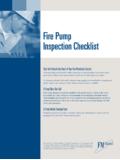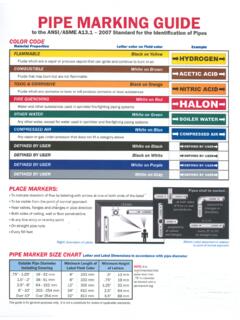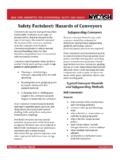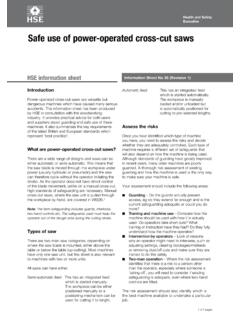Transcription of Paper Making Safeguarding Guide - ppsa.org
1 Paper Making Safeguarding Guide Identifying Some Best Practices within the Paper Making Industry 2005 Liberty Mutual Group - All Rights Reserved Table of Contents Recommended Safe Work Guidelines for Paper Making Operations 2005 Liberty Mutual Group - All Rights Reserved Approaches to Papermaking Safeguarding : General Head Box and 21 Winder and Paper Roll Wrap ..48 Converting ..52 Beater and Recovery ..56 Appendix A - Safeguarding Appendix B - Slip and Fall Prevention Appendix C - Machine Control Appendix D - Static Electricity Appendix E- Confined Space Entry.
2 90 Appendix F- Paper Making Safety The illustrations, instructions, and principles contained in the material are general in scope and, to the best of our knowledge, current at the time of publication. There is no attempt to interpret any referenced codes, standards, or regulations. Please refer to the appropriate code-, standard-, or regulation- Making authority for interpretation or clarification ( , US, European, Canadian, or ISO standards). Recommended Safe Work Guidelines for Paper Making Operations 2005 Liberty Mutual Group - All Rights Reserved Approaches To Paper Making Safeguarding : General Principles Recommended Safe Work Guidelines for Paper Making Operations - 2005 Liberty Mutual Group - All Rights Reserved The Paper machine and associated operations are hazardous due to their basic nature of high speed and pressure in-running rolls, elevated temperatures, wet and slippery conditions, and limited visibility areas.
3 Add to these physical conditions the need to manually feed, adjust, and observe the Paper marking process at many locations on the machine, often while the machine is running, and one can understand the difficulties encountered when attempting to design and provide safeguards. Because of the numerous in-running roll nips and rotating machines, much of the following document will deal with Safeguarding these hazards. Before addressing each section of the Paper machine individually, it is important to summarize some general concepts of machine guarding that will be applied.
4 A primary objective of machine safety is to never allow personnel to enter or access a hazardous area while the machine is operating. At the same time, it must be recognized that wide variations in Paper machine configurations exist, as does the need to provide access to each portion of the machine and its related power transmission equipment. General Safeguarding Approaches Hazards on your mill s Paper machines should first be identified and priorities established for Safeguarding , based on the severity of the exposure and likelihood of contact. A Job Safety Analysis (JSA) or other hazard identification method can help you systematically determine hazards, controls, and safe work procedures.
5 Look at other factors as well, such as improving ergonomics and minimizing occupational health exposures. Specific Safeguarding should then be designed, constructed, and installed. Consensus standards have been referenced throughout this document whenever possible. Safeguarding must be feasible and appropriate, so that employees will not try to remove a guard that seems impractical. Some safeguards and retrofit kits may be available from the original equipment manufacturer. After installing safeguards, be sure to monitor their effectiveness to determine if modifications are necessary.
6 The three most recognized methods of Safeguarding machinery are: Eliminating the Hazard Guarding of the Hazard Warning of the Hazard Elimination of a hazard by design is the most preferable, but in many situations it is not feasible. The second approach of guarding the hazard is more commonly found in industry. Warning of the hazard is the third approach, but it does not prevent access to hazards such as in-running nip points. It is also possible to use a combination of guarding, warning signs, and safety colors to help increase the effectiveness of the Safeguarding .
7 Additional Safety Considerations There may be cases where it is not practical to completely guard a machine. In these situations, develop supplementary protection such as providing automatic feeding methods, hand tools, and personal protective equipment. This is in addition to employee training, good housekeeping, preventive maintenance, and checking other items such as lighting and floor conditions. 1 General Principles Also, it is highly probable that many good ideas and Safeguarding designs will be developed, or already exist, to control each identified hazard.
8 Share successful ideas with other departments and facilities. Learn from each other s mistakes and successes. Safeguarding Methods There are six different methods of Safeguarding machines that will be illustrated here: 1. Fixed (structural barrier) guards 2. Interlocked guards and gates 3. Automatic safeguards 4. Safeguarding devices (presence sensing) 5. Safe distance 6. Safe location Shields also offer some protection between the hazard and the exposed worker; however it is not a common application the Paper Making industry. This method offers little resistance- in some cases, it is the only barrier of protection as it offers incomplete isolation of the hazards, and still allows one (at will) to reach over, under, or around to overcome that protection.
9 Therefore, shields will not be among those devices or safeguards examined here. These methods are listed in descending order of preference. The first three methods (fixed, interlocked, automatic) describe guards that are physical enclosures or barriers that prevent entry of hands, fingers, or other parts of the body into a hazard by reaching through, over, under, or around the guard. Guards should create no additional hazards between themselves and moving parts. They should utilize fasteners not easily removable by personnel, except for authorized individuals.
10 Several types of guards are suitable depending on how and where they are used. The latter three methods of Safeguarding devices, safe distance, and safe location should be explored only when effective guards are not feasible- controlling access, not preventing it. Refer to Appendix F for additional references, regulations, and standards that may apply to your operations. Recommended Safe Work Guidelines for Paper Making Operations - 2005 Liberty Mutual Group - All Rights Reserved 2 General Principles Recommended Safe Work Guidelines for Paper Making Operations - 2005 Liberty Mutual Group - All Rights Reserved Figure 1.










